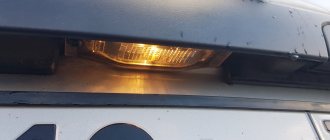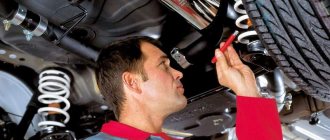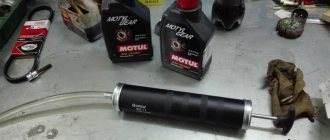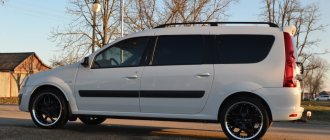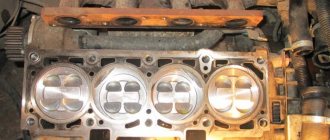Ever wondered how much the new Lada Largus actually costs? Actually, we are talking about a redesigned Dacia station wagon, and this brand belongs to Renault. That is, having decided to buy a VAZ minivan, in reality the choice is made in favor of Renault products. And even if the assembly is localized at VAZ, prices will still not be low. The basic configuration with a 5-seater cabin will cost 524 thousand, while a car with air conditioning will cost 566 thousand. True, you can use the “Trade In” program or recycle an old car - then the discount will be 30 thousand. But we will assume that the buyer does not use any of these programs.
A new car has been purchased, and the owner shares his impressions. Let's watch the video review.
Changes in the new Lada Largus
Since 2016, Renault K7M engines have not been installed in Largus family cars. Instead, VAZ got the 11189 engine, also 8-valve. It is better and more economical than its predecessor. And at the same time more expensive.
New development of VAZ - ICE 11189
Logan sedans, in turn, are also produced by AvtoVAZ. The motor that is installed in them is called K7M-800. This engine was previously installed on Largus minivans. Well, the prices were distributed like this:
- Largus (VAZ-11189, “Standard”) – 524 tr;
- Logan II (K7M, “Access”) – 469 rub.
It turns out that you have to pay 55 thousand extra for a station wagon and a new engine.
No less than 590 thousand rubles. you will have to pay for a car with a 7-seater body. But one row of seats cannot cost 66 thousand! The point is that not all configurations are available to owners of 7-seater cars, but only the most expensive ones.
For the same price as a Lada Largus for 7 seats, you can buy an “empty” Duster SUV. This is if you use the “Trade In” promotion when purchasing a Duster.
Timing diagram Lada Largus 8 valves
- 1 - crankshaft toothed pulley
- 2 - coolant pump toothed pulley
- 3 - tension roller
- 4 - rear protective cover
- 5 - camshaft gear pulley
- 6 - timing belt
- A - boss on the rear protective cover
- B - mark on the camshaft pulley
- C - mark on the oil pump cover
- D - mark on the crankshaft pulley.
Another feature of the engine is the location of the water pump (pump), which is rotated by the same timing belt. That is, in case of coolant leaks or characteristic noise/whistle/hum in the timing drive area, checking the belt is mandatory. If the pump bearing crumbles and the belt comes off, then in addition to replacing the water pump housing and belt, you will also have to go through the cylinder head, removing bent valves from there.
AvtoVAZ uses a very reliable Gates belt as the original belt. Often the service life of the Gates belt is much higher than the service life of the pump and tension pulley of the Lada Largus 8-valve engine.
Expanding the model line of the domestic automobile industry is a rather complex process that took a long time, and each new model turned out to be a very high achievement for the company. AvtoVAZ today is considered the largest car manufacturer in Russia, but its own developments within the company are becoming less and less. One of the successful models was the successor to the Renault Logan MCV station wagon. In the Russian version, this car was called Lada Largus, and potential buyers of domestic vehicles still had certain doubts about the technology of this car. Someone claims that the car is equipped with a Russian engine, modernized since the time of the “Classics”. Others say that under the hood of Largus there is a brave Frenchman with good potential. Today we will look into the characteristics of the Lada Largus.
Russian price grid for all Renault cars
At Renault, everything is arranged logically. For 469 thousand you can buy a sedan with an 8-valve internal combustion engine (we are talking about a new model range). Next comes the VAZ Largus model with its price tag of half a million. Well, then there are SUVs - prices there start at 629 thousand.
The most inexpensive Lada Largus
If you make a choice between a minivan and an SUV, you need to take into account the difference in engines:
- Largus: K4M-490 (16 cells, timing belt) or 11189 (8 cells, belt);
- Duster: H4M (1.6 l, chain) or F4R (2.0 l, belt).
We also note that the assembly of H4M engines has been localized, and they are produced in Tolyatti - in the same place where the K4M internal combustion engine is assembled. F4R engines, in turn, are still imported from Spain.
All engines for Largus are produced by AvtoVAZ. This rule has been in effect since January 2016.
Engine
LADA LARGUS cars are equipped with gasoline, in-line, 4-cylinder, 8- and 16 - valve engines with a displacement of 1.6 liters. with 2 or 4 valves per cylinder. The location of the power unit is front, transverse.
For engine identification number plate locations, see here. The ratio of installed engines and gearboxes in trim levels can be found here.
Until mid-2016, the car was equipped with Renault K7M (8-cl) and K4M (16-cl) engines.
Since 2016, their modern analogues produced by AvtoVAZ began to be installed. Accordingly, the K7M was replaced by the VAZ-11189 , and the K4M was replaced by the VAZ-21129 . The engines are distinguished by a lightweight ShPG, automatic timing belt tensioner, metal cylinder head gasket, body kit and supports.
Since 2022, Lada Largus CNG (with LPG) will be equipped with 21129 CNG dual-fuel engines.
Since 2022, instead of the VAZ-11189 engine, they began to install its deeply redesigned version - VAZ-11182 . Although the power did not increase significantly (from 87 to 90 hp 66 kW), the engine became noticeably more torquey, especially at low speeds. A large number of internal parts have undergone changes, incl. ShPG. One of the important changes in 11182 is that the motor has become “plug-inless”, i.e. the valves do not bend if the timing belt breaks.
| Engine | 11186 | 11182 | ||
| Pusher | Weight (pushrod, washer) | kg. | 0,0598 | 0,037 |
| Inlet valve | Rod/plate diameter | mm. | 8/36 | 5/36 |
| Weight | kg. | 0.0769 | 10,0543 | |
| Exhaust valve | Rod/plate diameter | mm. | 8/30,5 | 5/30,5 |
| Weight | kg. | 0,069 | 0,0466 | |
| Valve spring outer | Weight | G. | 37,2 | 〜 30 |
| Valve spring internal | Weight | G. | 15.45 g. | No |
| Valve spring retainer | Weight | G. | 16,9 | 11,5 |
Depending on the vehicle configuration, there are several options for installing auxiliary equipment on engines:
- a car with power steering;
— a car with non-power steering and air conditioning;
— a car with hydraulic power steering;
— a car with hydraulic power steering and air conditioning.
The main parameters and characteristics of the engines are given in tables 1 and 2.
Table 1 - Renault engines
Table 2 - engines produced by AVTOVAZ
* Permissible deviation of maximum power and maximum torque is no more than ±5% (in accordance with GOST 14846). Values are based on 95 octane gasoline. | |||||||||||||||||||||||||||||||||||||||||||||||||||||||||||||||||||||||||||||||||||||||||||||||||||||||||||||||
Engine manufactured by AVTOVAZ 1.6 l.
ENGINE 1.6 (8 valve, 84 hp)
The K7M engine is a gasoline, four-stroke, four-cylinder, in-line, eight-valve, overhead camshaft. The operating order of the cylinders is: 1–3–4–2, counting from the flywheel. Power supply system – distributed fuel injection (emission standards Euro 4).
Engine (front view): 1 — air conditioning compressor; 2 — drive belt; 3 - generator; 4 — power steering pump; 5 - oil dipstick; 6 — cylinder head cover; 7 - ignition coil; 8 — tips of explosive wires; 9 - cylinder head; 10 — thermostat housing; 11 — exhaust manifold; 12 — water pump pipe; 13 — insufficient oil pressure sensor; 14 - plug; 15 - flywheel; 16 — cylinder block; 17 — oil pan; 18 - oil filter
The engine, gearbox and clutch form the power unit - a single unit mounted in the engine compartment on three elastic rubber-metal supports. The right support is attached to the bracket on the top cover of the gas distribution mechanism drive, and the left and rear ones are attached to the gearbox housing. On the front of the engine (in the direction of vehicle movement) there are: exhaust manifold, oil filter, low oil pressure warning sensor, coolant pump supply pipe, spark plugs, generator, power steering pump, air conditioning compressor.
Power unit assembly (rear view): 1 — gearbox; 2 - crankshaft sensor; 3 — inlet pipeline; 4 — absolute air pressure sensor in the intake manifold; 5 — inlet air t sensor; 6 — throttle assembly; 7 — idle speed regulator; 8 — oil filler cap; 9 — fuel rail; 10 - oil dipstick; 11 - cylinder head; 12 — cylinder block; 13 - drive belt; 14 — oil pan; 15 — knock sensor; 16 — support bracket for the intake pipeline; 17 — starter; 18 — speed sensor
At the rear of the engine there are: an intake manifold with absolute pressure and intake air temperature sensors, a throttle assembly with a throttle position sensor and an idle speed regulator, a fuel rail with injectors, a knock sensor, a starter, and an oil level indicator. On the right is the coolant pump, timing gear and coolant pump drive (toothed belt), auxiliary drive drive (V-ribbed belt). On the left are: flywheel, thermostat, crankshaft position sensor, coolant temperature sensor. On top is the ignition coil, oil filler neck. The engine cylinder block is cast from cast iron, the cylinders are bored directly into the block. At the bottom of the cylinder block there are five crankshaft main bearing supports with removable caps, which are attached to the block with special bolts. The holes in the cylinder block for the bearings are machined with the covers installed, so the covers are not interchangeable and are marked on the outer surface to distinguish them (the covers are counted from the flywheel side). On the end surfaces of the middle support there are sockets for thrust half-rings that prevent axial movement of the crankshaft.
Engine (right view): 1 - drive belt; 2 — drive belt pulley; 3 — oil dipstick tube; 4 — support bracket for the intake pipeline; 5 — lower timing cover; 6 — inlet pipeline; 7 — throttle assembly; 8 — upper timing cover; 9 - oil filler cap; 10 — ignition coil; 11 — power steering pump pulley; 12 - generator; 13 — belt support roller; 14 — belt tension roller; 15 — air conditioning compressor pulley; 16 — engine sump
The crankshaft main and connecting rod bearing shells are made of steel, thin-walled, with an anti-friction coating applied to the working surfaces. Crankshaft with five main and four connecting rod journals. The shaft is equipped with four counterweights, integral with it. The counterweights are made on the continuation of the “cheeks” of the engine crankshaft. Counterweights are designed to balance the forces and moments of inertia that arise during the movement of the crank mechanism during engine operation. To supply oil from the main journals to the connecting rods, there are channels made in the journals and cheeks of the shaft. At the front end (toe) of the crankshaft there are installed: an oil pump drive sprocket, a timing gear drive pulley and an auxiliary drive pulley. The toothed pulley is fixed on the shaft with a protrusion that fits into a groove on the toe of the crankshaft and protects the pulley from turning. The auxiliary drive pulley is similarly fixed on the shaft.
Engine - left view: 1 - gearbox; 2 - air conditioning compressor; 3 - generator; 4 — thermostat; 5 — coolant t sensor; 6 - cylinder head; 7 — cylinder head cover; 8 — ignition coil; 9 — oil neck; 10 — fuel rail; 11 — throttle position sensor; 12 — throttle assembly; 13 — inlet pipeline; 14 — inlet air t sensor; 15 — absolute air pressure sensor in the intake manifold; 16 — cylinder block; 17 — crankshaft position sensor; 18 - speed sensor
The connecting rods are steel, I-section, processed together with the covers. The covers are attached to the connecting rods with special bolts and nuts. The piston pin is steel, tubular in section. The pin, pressed into the upper head of the connecting rod, rotates freely in the piston bosses. The piston is made of aluminum alloy. The piston skirt has a complex shape: barrel-shaped in the longitudinal section, oval in the transverse section. In the upper part of the piston there are three grooves machined for piston rings. The two upper piston rings are compression rings, and the lower one is oil scraper. Compression rings prevent gases from escaping from the cylinder into the engine crankcase and help remove heat from the piston to the cylinder. The oil scraper ring removes excess oil from the cylinder walls as the piston moves.
ENGINE 1.6 (16 valve, 105/102 hp)
The K4M engine is a gasoline, four-stroke, four-cylinder, in-line, sixteen-valve, with two overhead camshafts. The operating order of the cylinders is: 1–3–4–2, counting from the flywheel. Power supply system – distributed fuel injection (emission standards Euro 4). The engine, gearbox and clutch form the power unit - a single unit mounted in the engine compartment on three elastic rubber-metal supports. The right support is attached to the upper cover of the gas distribution mechanism drive, and the left and rear ones are attached to the gearbox housing.
Engine (front view in the direction of vehicle movement): 1 – air conditioning compressor; 2 – auxiliary drive belt; 3 – generator; 4 – power steering pump; 5 – upper cover of the gas distribution mechanism drive; 6 – oil filler cap; 7 – absolute air pressure sensor; 8 – intake air temperature sensor; 9 – knock sensor; 10 – receiver; 11 – fuel rail with injectors; 12 – inlet pipeline; 13 – cylinder head cover; 14 – oil level indicator; 15 – thermostat housing; 16 – cylinder head; 17 – coolant pump pipe; 18 – low oil pressure indicator sensor; 19 – plug; 20 – flywheel; 21 – cylinder block; 22 – oil pan; 23 – oil filter
Engine (rear view in the direction of vehicle movement): 1 – cylinder head; 2 – cylinder head cover; 3 – receiver; 4 – throttle unit; 5 – upper cover of the gas distribution mechanism drive; 6 – control oxygen concentration sensor; 7 – exhaust manifold; 8 – lower cover of the gas distribution mechanism drive; 9 – cylinder block; 10 – auxiliary drive belt; 11 – oil pan; 12 – oil drain plug
Engine (view on the right in the direction of vehicle movement): 1 – auxiliary drive belt; 2 – auxiliary drive pulley; 3 – cylinder block; 4 – lower heat shield of the exhaust manifold; 5 – upper heat shield of the exhaust manifold; 6 – control oxygen concentration sensor; 7 – exhaust manifold; 8 – lower cover of the gas distribution mechanism drive; 9 – upper cover of the gas distribution mechanism drive; 10 – throttle assembly; 11 – receiver; 12 – power steering pump pulley; 13 – belt support roller; 14 – generator; 15 – belt tensioner roller; 16 – air conditioning compressor pulley; 17 – oil pan
Engine (left view in the direction of vehicle movement) : 1 – flywheel; 2 – air conditioning compressor; 3 – oil filter; 4 – supply pipe of the coolant pump; 5 – generator; 6 – thermostat housing; 7 – power steering pump; 8 – cylinder head; 9 – receiver; 10 – cylinder head cover; 11 – cover of the cylinder head cooling jacket; 12 – coolant temperature sensor; 13 – cylinder block; 14 – upper heat shield of the exhaust manifold; 15 – exhaust manifold; 16 – lower heat shield of the exhaust manifold; 17 – exhaust manifold bracket
General recommendations for engine maintenance
Note: The information below is for general information purposes only and is not specific to any car brand.
Now, apparently, there is no point in remembering the legends of deep antiquity - all sorts of steam engines at the dawn of the automobile industry, Babbitt liners, lubrication by gravity and splashing... Yes, all this once also existed and even drove, but at the initial stage of any activity it is difficult to avoid difficulties. As scientific and technological progress grew, it was no longer necessary for a car owner to have a personal driver with a mechanic’s diploma and the skills of a car mechanic perfected to the point of automaticity. But still, the driver still had to have some understanding of the process, otherwise you wouldn’t go far. I pressed the gas one more time when starting the carburetor engine - I filled the spark plugs: unscrew and heat them up, or wait until they dry out, and time goes by... I forgot to connect the front axle and off-road locks - I got stuck. Have you forgotten that when driving out onto the asphalt again, you must turn off the second axle and release the differentials? Save money to replace the transfer case and gearbox.
And now? Everything is controlled electronically. Need to start the engine? Press all the pedals at once - the control unit, through high-precision injectors, will measure exactly as much fuel as needed, checking with numerous sensors and a flow meter. A car is a product of the collective mind, and it doesn’t matter where it was made - in Germany or in China, there are precedents, remember the same Haval. Does BMW use an all-wheel drive system from a leading Canadian company? Why are we worse? We will buy automatic transmissions from the same Germans, they say they are good. They are too lazy to develop the engine themselves, the Austrians offer, let’s take, perhaps, the Volkswagen Group used their services, and everyone was happy.
Now, when driving off the asphalt into impassable mud, you don’t need to think about anything - the automation will connect what is needed and lock the free differentials; on some models you don’t even need to touch the pedals - the car drives itself, just turn the steering wheel. If you don’t know how to park, an automatic parking attendant will help you; you don’t even need to turn the steering wheel. Didn't have time to slow down in front of a zebra? It doesn’t matter, the car will stop itself if there are pedestrians at the crossing, and it’s not for nothing that automakers charge so much money for Pre Safe systems. Actually, autopilots are already being tested with all their might, even in our country we have our own developments from the same Yandex, a little more and...
This is where the good news ends. Now the news is bad. It's not that they are bad for everyone, but rather for some. It is sad that 90% of the population of our country belongs to these “some”. The following story is dedicated to these car enthusiasts. Global practice in relation to road transport is such that the obsolescence of promising technology occurs very quickly. Toxicity standards are constantly changing, and ubiquitous electronics are taking on more and more functions. Against this background, the resources of power units of 500,000 - 1,000,000 km and no longer suit anyone. Marketing is also on the alert - programmed aging, irreparable components and assemblies. On the one hand, it is understandable - in prosperous Germany or the USA, all this is relevant, but here, with such a standard of living, such innovations simply pull the rug out from under our feet - with such a level of automobile mobilization, road network and prosperity, new realities are perceived purely negatively. Few Russian citizens can afford a car for 3-10 million with all these bells and whistles and replace it every 3-5 years.
Fortunately, automakers understand that in the world there are not only developed countries like the USA, Germany, Japan, France, etc., but also developing countries like Iran, Nigeria, Angola, Sudan, and now Russia, so cars, those supplied there are often very different from promising technology, and, according to our realities, for the better.
By the way, Eastern Europe has not yet become so mature in prosperity, and good news often comes from there, supported by the necessary models. Take, for example, a division of the Volkswagen Group, the Skoda company: it has a unique situation - the Czechs often offer new models with proven old units, but who else does that? Try to buy a Volkswagen Passat without turbocharging, direct injection and a preselective gearbox - it won’t work. Of the simple models, only Volkswagen Polo. If you want prestige and convenience, shell out for the latest technologies and programmable aging, which are inherent in all units of new models from the very beginning. In essence, the consumer is asked to pay out of his own pocket for the fact that a prestigious new car will soon fall apart, and it will not be possible to repair it or somehow significantly delay the date of death - everything has been thought out. From a logical point of view, the situation is wildest, and even rich Western Europe understands this, which is why in some Frankfurt or Dusseldorf it is Skodas that work as taxis - up to 70% of the entire fleet. It is enough to look out of the airport window to see this. Taxi drivers can be understood - the indestructible atmospheric MPI developed twenty years ago and the classic automatic transmission will clearly last longer than the promising TSI and DSG, perhaps many times, despite the gentle conditions of European operation.
Mitsubishi at one time introduced its new GDI development to the European, including Russian, market, however, having discovered reliability problems, a few years later it removed GDI engines from the European market as a whole - it turned out that European gasoline contains a lot of sulfur, which the developers We didn’t count on it, since Japan has its own GOST standards for foreign impurities. But, unfortunately, not everyone does this. Usually it turns out exactly the opposite. An icon of marketing style and one of the worst engines in the history of the automotive industry, the N63 engine from BMW. Actually, BMW knows how to make engines, how did it happen that now not only the top-end N63, but also the rest of the concern’s modern power units are not reliable? Yes, everything is simple, this is how it is now accepted, but even against this background the N63 is unique. The mechanical life is up to 60,000 km, and it is not a fact that before this period we will not have to change the turbines a couple of times, since they are in the hottest place, however, the entire engine is very overheated. Injectors tend to “flow”, leading to water hammer; in general, the engine consists of practically nothing but problems, the elimination of which is extremely expensive. How did it happen that it is on the most popular top models: “seven”, “six”, “five”, X5, X6? Moreover, it did not even stay within the brand and at one time occupied a place under the hoods of tone-on-tone Range Rover. It’s just that Bavarian marketers got into the very heart of the Target Group - what do officials, top managers and simply very wealthy people who don’t count money care about operating costs? For some, the population pays, for others, the company that owns the corporate park pays, and for others, it is important to show off their “I”, and no money is spared for this. The lifespan of a car is a maximum of a couple of years, then you just get tired of it, and the mileage of such vehicles is low. In general, nowadays you shouldn’t focus on premium segment cars, even with low mileage - apart from problems, you’re unlikely to get anything. The rest of the promising and, especially, premium equipment is designed in a similar way, so if you do not have the task of constantly spending serious sums on repairs and the purchase of the next car, it is better to turn your gaze in the other direction.
This entire preface was written for a reason. If we are talking today about the health of the engine and its longevity, then the first item on the agenda will, of course, be the choice of the power unit, so that then we can simply carry out scheduled maintenance without any repairs, replacement of components, vessels with warranty departments of dealer organizations and other similar inconveniences that are common drag on for a very long time, especially in our country.
So let's start with direct injection. Against the background of the Russian economic miracle: when fuel in wholesale is more expensive than in retail, it is ridiculous to expect proper quality from gasoline and diesel fuel, but direct injection is a highly precise thing and does not like it. Of course, modern systems like Di-Motronic and Neo-Di are not as gentle as the ever-memorable GDI, but when buying a car, you should avoid direct injection if possible, especially since, in addition to reliability, spare parts for such systems are many times more expensive. There’s no escape from diesel – Common Rail is now without alternative. However, in this case, it is better to study the issue before purchasing. For example, diesel engines from PSA performed well even in Russia, which cannot be said about heavy fuel combustion engines from a number of other companies.
Accordingly, it is better to prefer standard distributed injection when it comes to gasoline - Motronic or its Asian analogues. These systems are still actively used by automakers, and not only in the budget segment. It is better to avoid supercharged internal combustion engines, especially the much-loved VW Group double supercharging TSI with a turbine and compressor, high power and tiny volume - you should not expect a decent resource from such small-capacity engines, especially if it happens that no one will repair it for you. It is also unlikely that this downsizing miracle will be recapitalized - there is neither a safety margin nor room for introducing sleeves. In modern times, turbines themselves also reduce the service life of the unit, since supercharging is good only to a certain limit - if you remove 360 hp from two liters, as Mercedes-Benz did on its A 450 AMG, you can expect a decent resource from such an engine funny. In addition, modern turbines themselves are now the weak link, especially if they are placed closer to hot catalysts, like some BMW models, and they cost a lot of money.
In general, having discarded everything that is promising and irrelevant for Russian realities, we get an aspirated engine with distributed injection - this is by far the most durable design, and extending the life of such a motor, despite all the marketing tricks, is a very realistic task.
But even if you find a car with the desired engine in a car dealership, it would be nice to pay attention to one more aspect - the start-stop system. Simply having it is not a reason to refuse a purchase if it is possible to programmatically turn it off forever. And if not? Think for yourself how convenient it will be for you to turn off the automatically activated system every time you start the engine. In developed countries, it may allow you to save a little fuel at the expense of the service life of the engine and starter, but in the dead Moscow traffic jams such savings will definitely backfire, especially since the battery for “start-stop” is 2-3 times more expensive than usual, and in general all the electrics are their own, quite expensive.
High-quality lubricants and consumables for maintenance are already the key to success. The sad thing is that now even the automaker is trying to push the user into making the wrong choice. For example, when selecting an oil filter for World Engine, the well-known “aspirated” Mitsubishi, which was installed on Peugeot, Citroen, Hyundai, Kia, JEEP, Dodge, Fiat, it suddenly turns out that now, in addition to the original filter number, the program also gives a strong recommendation use oil no thicker than 5W-30, straight from the original JEEP program. This section never contained such information at all, where did it come from now? And why exactly like this? After all, just a few years ago the recommendations were opposite and quite understandable. Has the motor changed from a mechanical point of view? No. The answer is simple. Excellent performance characteristics, but outdated, according to environmentalists, the World Engine with distributed injection has great difficulty meeting modern draconian toxicity standards, and in order to be able to sell cars with similar power units, cars, including reducing internal resistance by using a thinner lubricant . The method is so-so - the classic “aspirated” engine definitely won’t like this, but from a marketing point of view it’s even better: the engine will fail faster - the buyer will buy a new car faster.
So, regarding motor oil, there is only one recommendation: do not use a hot viscosity less than 40, and if you like to rev the engine, it is better not less than 50. We have roughly decided on the viscosity. Now the composition. Nowadays, unfortunately, it is difficult to distinguish hydrocracking oil from synthetic oil at a retail outlet - they are labeled the same, and special equipment is needed to measure the flash point. But it’s worth remembering that hydrocracking oils last a third less, so when buying inexpensive synthetics, you need to understand that the canister contains a 99% hydrocracking product. In modern times, it is undesirable to take mineral water, unless, of course, you have a completely ancient power unit: it lasts even less, and its lubricating characteristics are much less stable depending on temperature. Semi-synthetics are an average option; they also need to be changed quite often, and this is logically understandable. Now to the question of the oil change interval. Based on engine hours (which is what all overseas equipment is based on), dealer mileage recommendations should be divided by two. Oil in dead traffic jams ages even faster than on the move, so if you are moving in a large city, this point needs to be taken into account.
The last, but also extremely important recommendation is constant monitoring of the cooling system. There is some confusion among manufacturers of technical fluids regarding the colors of the antifreeze used, so you need to focus not on the color, but on the composition of the antifreeze. It is necessary to observe the replacement periods and drain the coolant from the system as a whole, and not in parts, adding portions of fresh product. A very important point is the condition of the cooling radiator. If it is clogged with dirt, heat exchange is difficult, but now there can be only a few degrees between the temperature of the thermostat opening point and the system boiling point - everyone is chasing efficiency, and you can’t fool thermodynamics. So it is also necessary to closely monitor the radiator, preventing the heat transfer from deteriorating; in other words, it must be washed in a timely manner.
And the last, most banal piece of advice is to be wary of counterfeit products, the number of which is growing at a tremendous pace. If you use “scorched” oil, left-handed filters and refuel at suspicious gas stations, “where it’s a whole ruble cheaper,” retribution will follow immediately. So it’s better not to save on consumables for maintenance and technical fluids, buying everything at large and trusted retail outlets.
Video
What if...
If VAZ bothers to create an affordable 7-seater configuration, then it will cost 548 thousand. Let's check:
- 5-seater Largus (Norma + Climate package) cost 566 TR;
- The price of 7-seater cars with the same equipment is 590 thousand.
The difference (24 thousand) must be added to the base price. The result will be exactly 548.
“7-seater Standard” – when will it be released?
At the beginning of 2016, the management at VAZ changed. By that time, it was already clear that the packages were formed according to the principle: “If it’s a little better, let them pay the maximum.” Suffice it to remember what Largus Cross is and in which version the Niva with galvanization is offered (Niva Urban). But now, in 2016 and beyond, the principles will change. This means that new configurations should appear that will be in demand among buyers.
Third row of seats
There is one gap left in the list of configurations for the Largus minivan - there is no available version in a 7-seater body. This means that this gap will be filled sooner or later. A minivan with 7 seats that costs 548 thousand is what the buyer needs, and of course AvtoVAZ knows about it.
Main prospects for the development of the Russian Lada Largus project
In the form in which it is now, the Largus project will not be able to exist. We'll have to work hard to maintain the model's potential popularity. And the main efforts will be in updating the design, changing power units to decent options, which is important, and also in decoupling the cost of the car from the foreign exchange rate. There are many options for further actions by the company that will help completely change the fate of the currently not entirely successful model. Among the most popular proposed steps, the following solutions are quite adequate for the company:
- development of a new line of engines that would meet the requirements of environmental friendliness and power;
- purchasing the design of a new generation Renault Logan car or carrying out a facelift;
- replacement of all imported components of the car, of which there are too many in the design today;
- complete change of interior design features, improvement of driver ergonomics and ride comfort;
- work on the practicality of the car, changing the suspension, which today causes a lot of discomfort to rear passengers;
- increasing the vehicle's carrying capacity for use as a cargo van with two passenger seats;
- addition of complete sets with more comprehensive technologies for comfort and ride quality.
It should be noted that most of the proposals come from customer reviews about Largus. Many people condescendingly say that this is a quite good invention of the Russian automobile concern. Others claim that there was no point in inheriting Renault Logan if Largus was actually made objectively worse. In terms of cost, a car today in the cheapest configuration in the form of a 5-seater station wagon costs 500,000 rubles, which in no way explains the meaning of the Russian production of the car. Many questions have accumulated for the domestic manufacturer, and these questions need to be given a worthy answer. We invite you to watch a review of the Lada Largus Cross:
About the domestic VAZ 11189 engine
In April 2016, AvtoVAZ began installing domestic VAZ 11189 engines on Largus. The advantages of this engine are described in one of the issues of “Okay Mechanics”.
| Some measurement results Autoreview | |||
| Options | Cars | ||
| Lada Largus (VAZ engine) | Lada Largus (Renault engine) | ||
| Maximum speed, km/h | 157,1/156,7* | 168,0/167,6 | |
| Acceleration time, s | 0—50 km/h | 4,3/4,8 | 3,9/4,4 |
| 0—100 km/h | 13,9/16,8 | 12,5/14,5 | |
| 0—150 km/h | 61,1/71,6 | 38,9/43,7 | |
| on the way 400 m | 19,3/20,2 | 18,4/19,4 | |
| on the way 1000 m | 36,1/37,8 | 34,1/36,0 | |
| 60-100 km/h (III) | 8,7/10,6 | 9,3/10,6 | |
| 60-100 km/h (IV) | 12,1/15,1 | 12,8/14,1 | |
| 80-120 km/h (V) | 19,3/24,0 | 22,1/23,4 | |
| * Partial load/full load | |||
| Engine characteristics | ||
| Options | VAZ-11189 | Renault K4M |
| Volume, cm 3 | 1596 | 1598 |
| Number of valves | 8 | 16 |
| Maximum power, hp/kW/rpm | 87/64/5100 | 102/75/5750 |
| Maximum torque, Nm/rpm | 140/3800 | 145/3750 |
| Cylinder diameter/piston stroke, mm | 82,0/ 75,6 | 79,5/80,5 |
| Compression ratio | 10,3:1 | 9,8:1 |
| Injection type | distributed, electronically controlled | |
| Octane number of gasoline | at least 92 | not less than 95 |
Let us remind you that you can read about the VAZ 21129 engine here.
Key words: Lada Largus engine
“>
Description of the K4M engine (Renault Logan/Sandero/Largus)
It is a development of the K7M series, with a new cylinder head, already 16 valve. There are many differences: K4M is quieter, it is more economical, there are no vibrations and many other advantages.
- expensive spare parts.
- If the belt breaks, the valve bends; it is recommended to change the belt every 60 thousand km.
- there are failures in work.
- Low-quality fuel causes the revs to fluctuate.
- troit (most often the problem is in the ignition coil, injectors or spark plugs).
- Unstable operation and floating speed are usually caused by the crankshaft position sensor or ignition coil.
If you choose between K7M and K4M, then the choice should definitely remain with the more modern and practical K4M.
Description of the K7M engine (Renault Logan/Sandero/Largus)
In 2010, the K7M 800 engine appeared, which replaced the K7M 710. No design changes occurred, except that the engine was strangled, bringing it up to the Euro-4 environmental standard, while the power decreased from 86 hp to 83 hp. With.
The disadvantages of the engine remain the same:
- high fuel consumption.
- At idle the speed often fluctuates.
- Every 20-30 thousand km the valves need to be adjusted.
- no hydraulic compensators.
- If the belt breaks, the valve bends; it is recommended to change the belt every 60 thousand km.
- crankshaft oil seal leaking.
- the engine is noisy.
- there are vibrations during operation.
If you look at the engine from the positive side, it is worth noting its high reliability; according to the passport, the engine life is about 400 thousand km, but in practice it is a little more.



